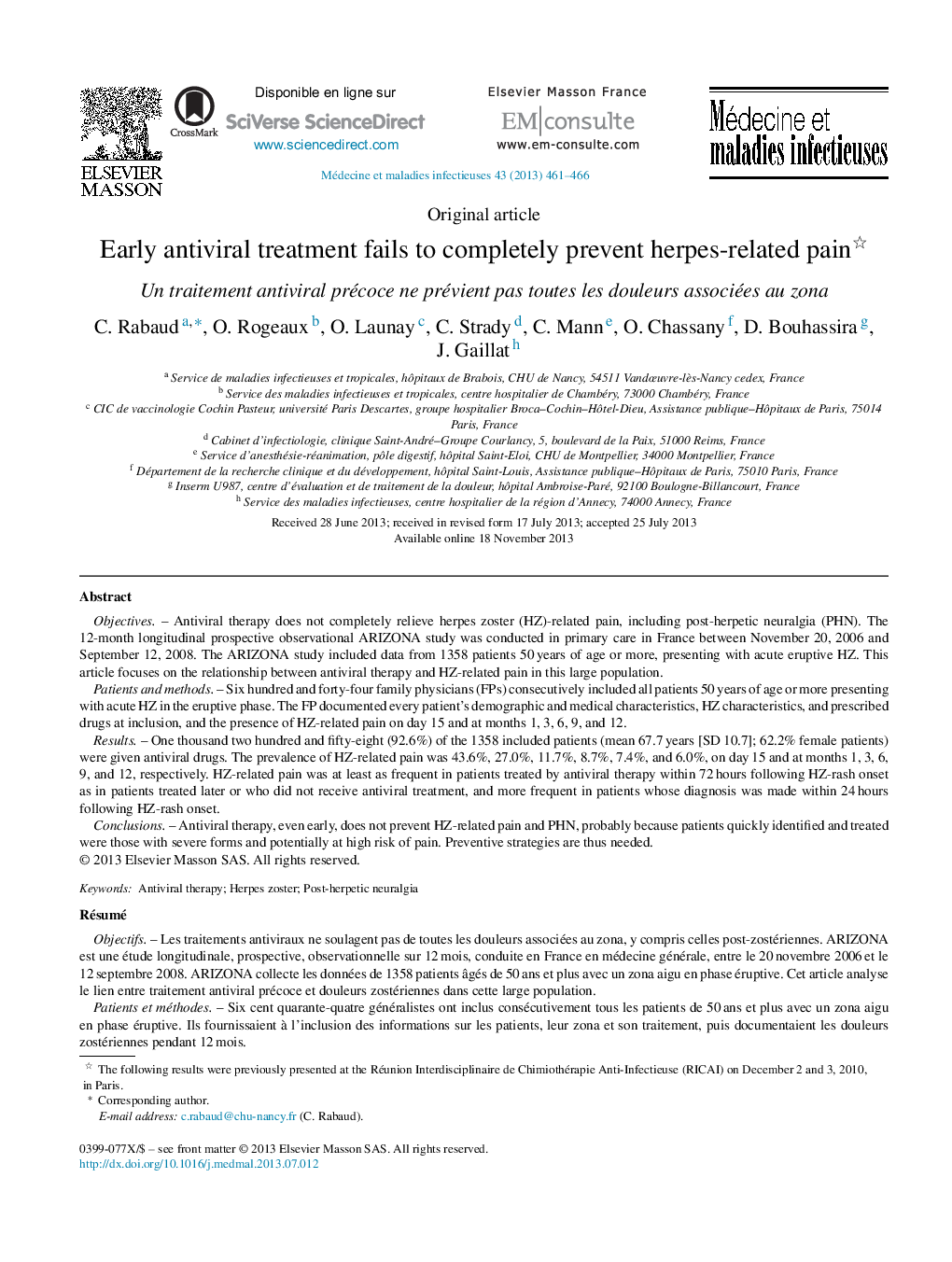| کد مقاله | کد نشریه | سال انتشار | مقاله انگلیسی | نسخه تمام متن |
|---|---|---|---|---|
| 3412872 | 1593614 | 2013 | 6 صفحه PDF | دانلود رایگان |

ObjectivesAntiviral therapy does not completely relieve herpes zoster (HZ)-related pain, including post-herpetic neuralgia (PHN). The 12-month longitudinal prospective observational ARIZONA study was conducted in primary care in France between November 20, 2006 and September 12, 2008. The ARIZONA study included data from 1358 patients 50 years of age or more, presenting with acute eruptive HZ. This article focuses on the relationship between antiviral therapy and HZ-related pain in this large population.Patients and methodsSix hundred and forty-four family physicians (FPs) consecutively included all patients 50 years of age or more presenting with acute HZ in the eruptive phase. The FP documented every patient's demographic and medical characteristics, HZ characteristics, and prescribed drugs at inclusion, and the presence of HZ-related pain on day 15 and at months 1, 3, 6, 9, and 12.ResultsOne thousand two hundred and fifty-eight (92.6%) of the 1358 included patients (mean 67.7 years [SD 10.7]; 62.2% female patients) were given antiviral drugs. The prevalence of HZ-related pain was 43.6%, 27.0%, 11.7%, 8.7%, 7.4%, and 6.0%, on day 15 and at months 1, 3, 6, 9, and 12, respectively. HZ-related pain was at least as frequent in patients treated by antiviral therapy within 72 hours following HZ-rash onset as in patients treated later or who did not receive antiviral treatment, and more frequent in patients whose diagnosis was made within 24 hours following HZ-rash onset.ConclusionsAntiviral therapy, even early, does not prevent HZ-related pain and PHN, probably because patients quickly identified and treated were those with severe forms and potentially at high risk of pain. Preventive strategies are thus needed.
RésuméObjectifsLes traitements antiviraux ne soulagent pas de toutes les douleurs associées au zona, y compris celles post-zostériennes. ARIZONA est une étude longitudinale, prospective, observationnelle sur 12 mois, conduite en France en médecine générale, entre le 20 novembre 2006 et le 12 septembre 2008. ARIZONA collecte les données de 1358 patients âgés de 50 ans et plus avec un zona aigu en phase éruptive. Cet article analyse le lien entre traitement antiviral précoce et douleurs zostériennes dans cette large population.Patients et méthodesSix cent quarante-quatre généralistes ont inclus consécutivement tous les patients de 50 ans et plus avec un zona aigu en phase éruptive. Ils fournissaient à l’inclusion des informations sur les patients, leur zona et son traitement, puis documentaient les douleurs zostériennes pendant 12 mois.RésultatsMille deux cent cinquante-huit (92,6 %) des 1358 patients inclus (moyenne 67,7 ans [ET 10,7] ; 62,2 % de femmes) recevaient un médicament antiviral. La prévalence des douleurs zostériennes était de 43,6 %, 27,0 %, 11,7 %, 8,7 %, 7,4 % et 6,0 % respectivement au 15e jour puis à un, trois, six, neuf et 12 mois. Les douleurs zostériennes étaient au moins aussi fréquentes chez les patients traités précocement (≤ 72 heures après le rash) que chez ceux traités plus tardivement ou non traités, et plus fréquentes lors de diagnostic précoce (≤ 24 heures).ConclusionsUn traitement antiviral, même précoce, ne prévient pas toutes les douleurs zostériennes et post-zostériennes, probablement parce que les patients identifiés et traités rapidement sont ceux ayant des formes de zona sévères, à haut risque de douleurs. Des stratégies préventives sont donc nécessaires.
Journal: Médecine et Maladies Infectieuses - Volume 43, Issues 11–12, December 2013, Pages 461–466